HI6028 Taxation Theory, Practice and Law Final Assessment T1
VerifiedAdded on 2022/11/25
|6
|1555
|204
Homework Assignment
AI Summary
This document presents a detailed solution to the HI6028 Taxation Theory, Practice and Law final assessment, covering key aspects of Australian taxation. It addresses the criteria for individual and company residency, referencing the Income Tax Assessment Act 1936 and relevant case law. The solution analyzes allowable deductions, including provisions for doubtful debts, speeding fines, solicitor fees, and travel costs. It also includes calculations for depreciation using prime cost and diminishing value methods for machinery and a car. The assessment further explores the tax consequences for a partnership, considering assessable income, deductible expenses, and partner distributions. Additionally, it calculates capital gains tax (CGT) consequences for an artist's asset sales, differentiating between personal and business assets. Finally, it defines and provides examples of tax evasion and tax avoidance. The document adheres to the assessment's instructions, providing answers within the specified answer boxes.
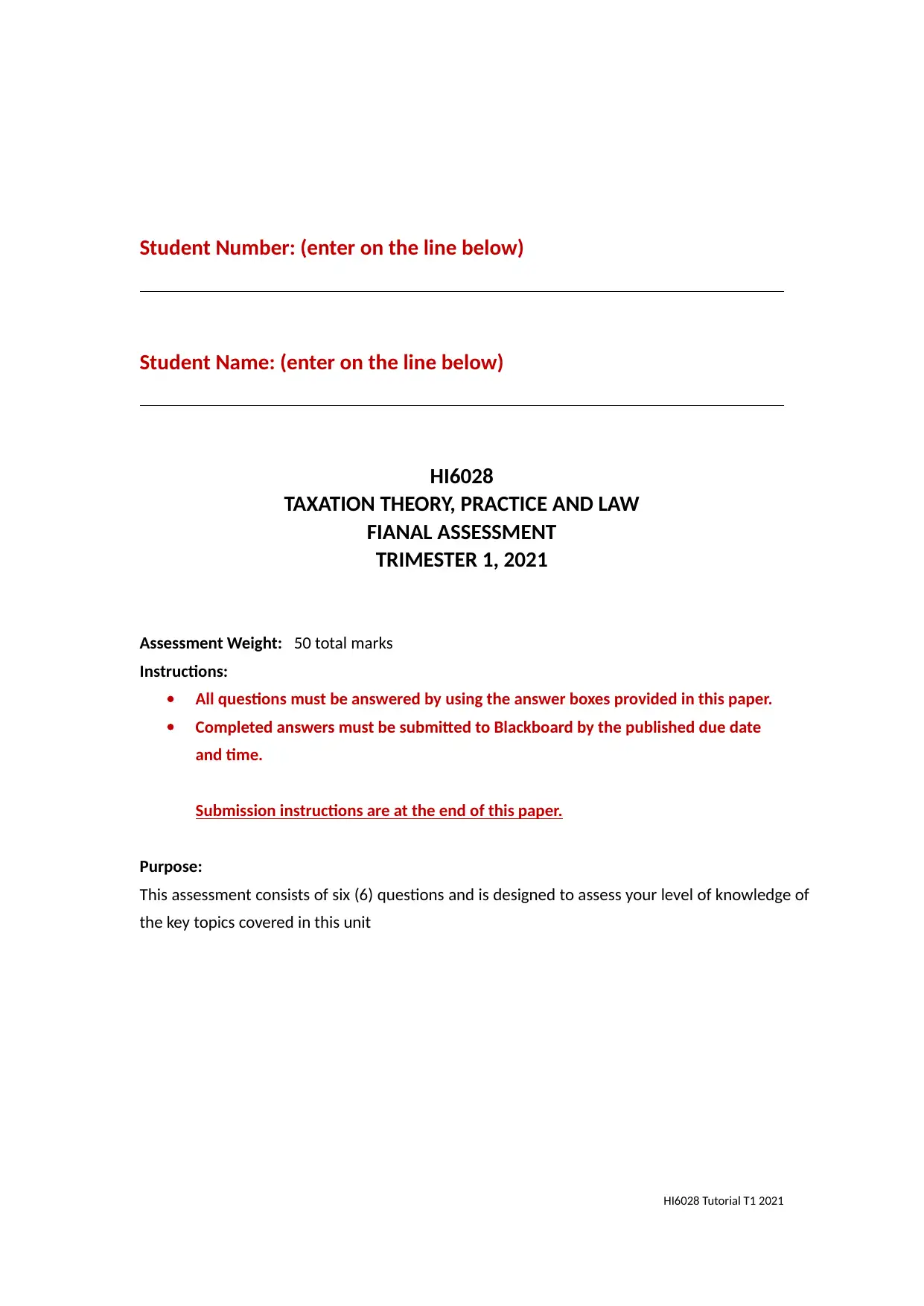
Student Number: (enter on the line below)
Student Name: (enter on the line below)
HI6028
TAXATION THEORY, PRACTICE AND LAW
FIANAL ASSESSMENT
TRIMESTER 1, 2021
Assessment Weight: 50 total marks
Instructions:
All questions must be answered by using the answer boxes provided in this paper.
Completed answers must be submitted to Blackboard by the published due date
and time.
Submission instructions are at the end of this paper.
Purpose:
This assessment consists of six (6) questions and is designed to assess your level of knowledge of
the key topics covered in this unit
HI6028 Tutorial T1 2021
Student Name: (enter on the line below)
HI6028
TAXATION THEORY, PRACTICE AND LAW
FIANAL ASSESSMENT
TRIMESTER 1, 2021
Assessment Weight: 50 total marks
Instructions:
All questions must be answered by using the answer boxes provided in this paper.
Completed answers must be submitted to Blackboard by the published due date
and time.
Submission instructions are at the end of this paper.
Purpose:
This assessment consists of six (6) questions and is designed to assess your level of knowledge of
the key topics covered in this unit
HI6028 Tutorial T1 2021
Paraphrase This Document
Need a fresh take? Get an instant paraphrase of this document with our AI Paraphraser
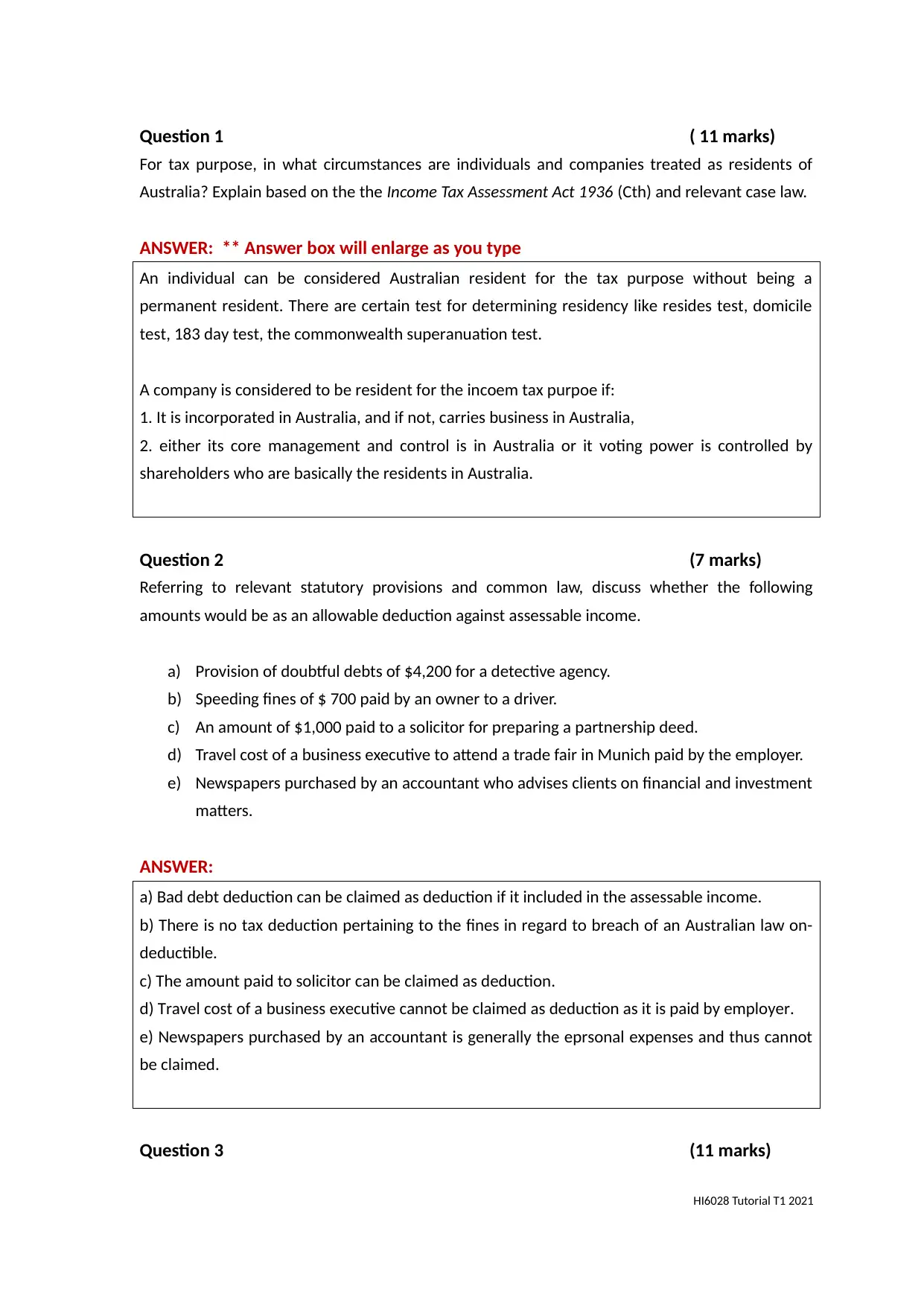
Question 1 ( 11 marks)
For tax purpose, in what circumstances are individuals and companies treated as residents of
Australia? Explain based on the the Income Tax Assessment Act 1936 (Cth) and relevant case law.
ANSWER: ** Answer box will enlarge as you type
An individual can be considered Australian resident for the tax purpose without being a
permanent resident. There are certain test for determining residency like resides test, domicile
test, 183 day test, the commonwealth superanuation test.
A company is considered to be resident for the incoem tax purpoe if:
1. It is incorporated in Australia, and if not, carries business in Australia,
2. either its core management and control is in Australia or it voting power is controlled by
shareholders who are basically the residents in Australia.
Question 2 (7 marks)
Referring to relevant statutory provisions and common law, discuss whether the following
amounts would be as an allowable deduction against assessable income.
a) Provision of doubtful debts of $4,200 for a detective agency.
b) Speeding fines of $ 700 paid by an owner to a driver.
c) An amount of $1,000 paid to a solicitor for preparing a partnership deed.
d) Travel cost of a business executive to attend a trade fair in Munich paid by the employer.
e) Newspapers purchased by an accountant who advises clients on financial and investment
matters.
ANSWER:
a) Bad debt deduction can be claimed as deduction if it included in the assessable income.
b) There is no tax deduction pertaining to the fines in regard to breach of an Australian law on-
deductible.
c) The amount paid to solicitor can be claimed as deduction.
d) Travel cost of a business executive cannot be claimed as deduction as it is paid by employer.
e) Newspapers purchased by an accountant is generally the eprsonal expenses and thus cannot
be claimed.
Question 3 (11 marks)
HI6028 Tutorial T1 2021
For tax purpose, in what circumstances are individuals and companies treated as residents of
Australia? Explain based on the the Income Tax Assessment Act 1936 (Cth) and relevant case law.
ANSWER: ** Answer box will enlarge as you type
An individual can be considered Australian resident for the tax purpose without being a
permanent resident. There are certain test for determining residency like resides test, domicile
test, 183 day test, the commonwealth superanuation test.
A company is considered to be resident for the incoem tax purpoe if:
1. It is incorporated in Australia, and if not, carries business in Australia,
2. either its core management and control is in Australia or it voting power is controlled by
shareholders who are basically the residents in Australia.
Question 2 (7 marks)
Referring to relevant statutory provisions and common law, discuss whether the following
amounts would be as an allowable deduction against assessable income.
a) Provision of doubtful debts of $4,200 for a detective agency.
b) Speeding fines of $ 700 paid by an owner to a driver.
c) An amount of $1,000 paid to a solicitor for preparing a partnership deed.
d) Travel cost of a business executive to attend a trade fair in Munich paid by the employer.
e) Newspapers purchased by an accountant who advises clients on financial and investment
matters.
ANSWER:
a) Bad debt deduction can be claimed as deduction if it included in the assessable income.
b) There is no tax deduction pertaining to the fines in regard to breach of an Australian law on-
deductible.
c) The amount paid to solicitor can be claimed as deduction.
d) Travel cost of a business executive cannot be claimed as deduction as it is paid by employer.
e) Newspapers purchased by an accountant is generally the eprsonal expenses and thus cannot
be claimed.
Question 3 (11 marks)
HI6028 Tutorial T1 2021
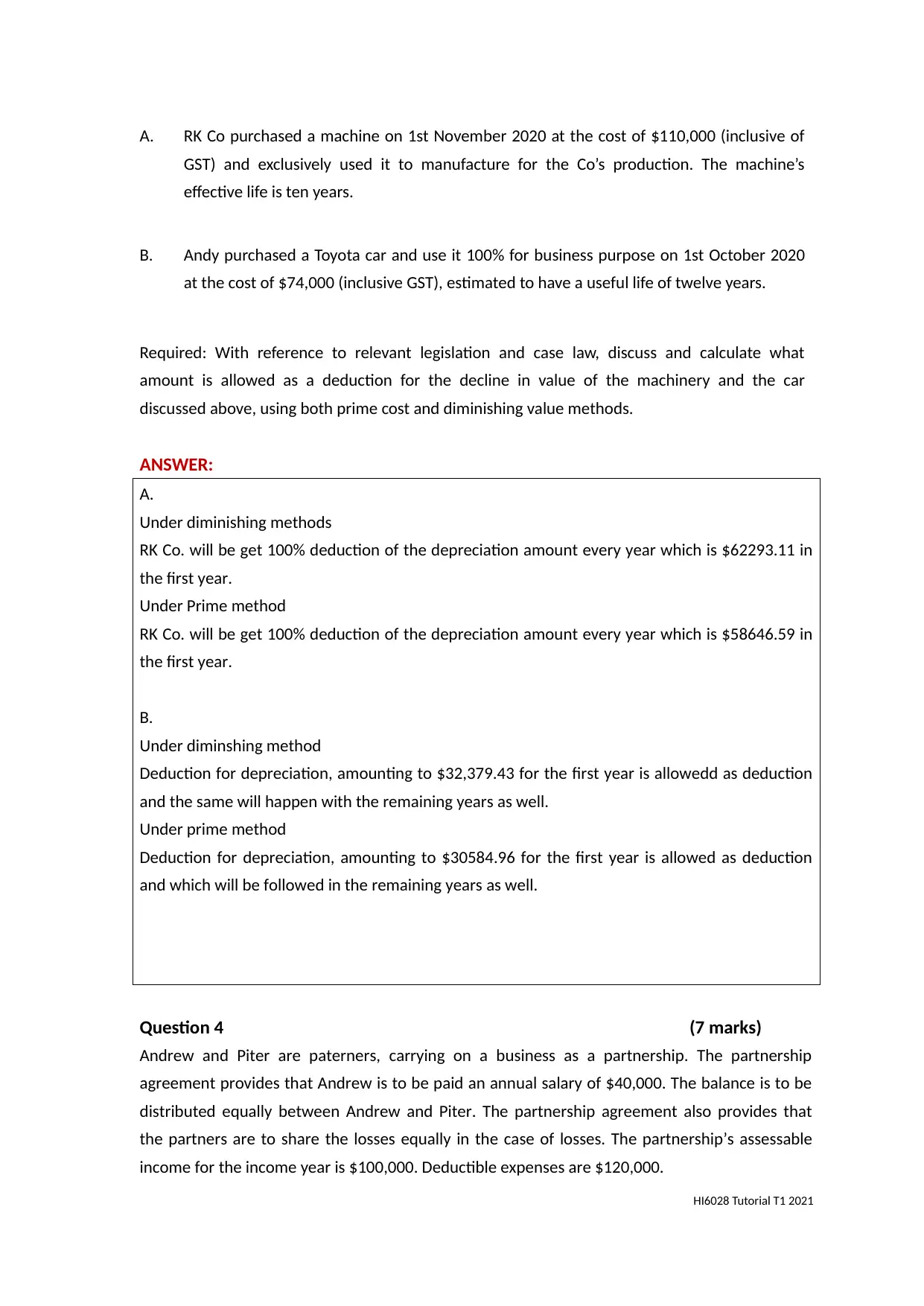
A. RK Co purchased a machine on 1st November 2020 at the cost of $110,000 (inclusive of
GST) and exclusively used it to manufacture for the Co’s production. The machine’s
effective life is ten years.
B. Andy purchased a Toyota car and use it 100% for business purpose on 1st October 2020
at the cost of $74,000 (inclusive GST), estimated to have a useful life of twelve years.
Required: With reference to relevant legislation and case law, discuss and calculate what
amount is allowed as a deduction for the decline in value of the machinery and the car
discussed above, using both prime cost and diminishing value methods.
ANSWER:
A.
Under diminishing methods
RK Co. will be get 100% deduction of the depreciation amount every year which is $62293.11 in
the first year.
Under Prime method
RK Co. will be get 100% deduction of the depreciation amount every year which is $58646.59 in
the first year.
B.
Under diminshing method
Deduction for depreciation, amounting to $32,379.43 for the first year is allowedd as deduction
and the same will happen with the remaining years as well.
Under prime method
Deduction for depreciation, amounting to $30584.96 for the first year is allowed as deduction
and which will be followed in the remaining years as well.
Question 4 (7 marks)
Andrew and Piter are paterners, carrying on a business as a partnership. The partnership
agreement provides that Andrew is to be paid an annual salary of $40,000. The balance is to be
distributed equally between Andrew and Piter. The partnership agreement also provides that
the partners are to share the losses equally in the case of losses. The partnership’s assessable
income for the income year is $100,000. Deductible expenses are $120,000.
HI6028 Tutorial T1 2021
GST) and exclusively used it to manufacture for the Co’s production. The machine’s
effective life is ten years.
B. Andy purchased a Toyota car and use it 100% for business purpose on 1st October 2020
at the cost of $74,000 (inclusive GST), estimated to have a useful life of twelve years.
Required: With reference to relevant legislation and case law, discuss and calculate what
amount is allowed as a deduction for the decline in value of the machinery and the car
discussed above, using both prime cost and diminishing value methods.
ANSWER:
A.
Under diminishing methods
RK Co. will be get 100% deduction of the depreciation amount every year which is $62293.11 in
the first year.
Under Prime method
RK Co. will be get 100% deduction of the depreciation amount every year which is $58646.59 in
the first year.
B.
Under diminshing method
Deduction for depreciation, amounting to $32,379.43 for the first year is allowedd as deduction
and the same will happen with the remaining years as well.
Under prime method
Deduction for depreciation, amounting to $30584.96 for the first year is allowed as deduction
and which will be followed in the remaining years as well.
Question 4 (7 marks)
Andrew and Piter are paterners, carrying on a business as a partnership. The partnership
agreement provides that Andrew is to be paid an annual salary of $40,000. The balance is to be
distributed equally between Andrew and Piter. The partnership agreement also provides that
the partners are to share the losses equally in the case of losses. The partnership’s assessable
income for the income year is $100,000. Deductible expenses are $120,000.
HI6028 Tutorial T1 2021
⊘ This is a preview!⊘
Do you want full access?
Subscribe today to unlock all pages.

Trusted by 1+ million students worldwide
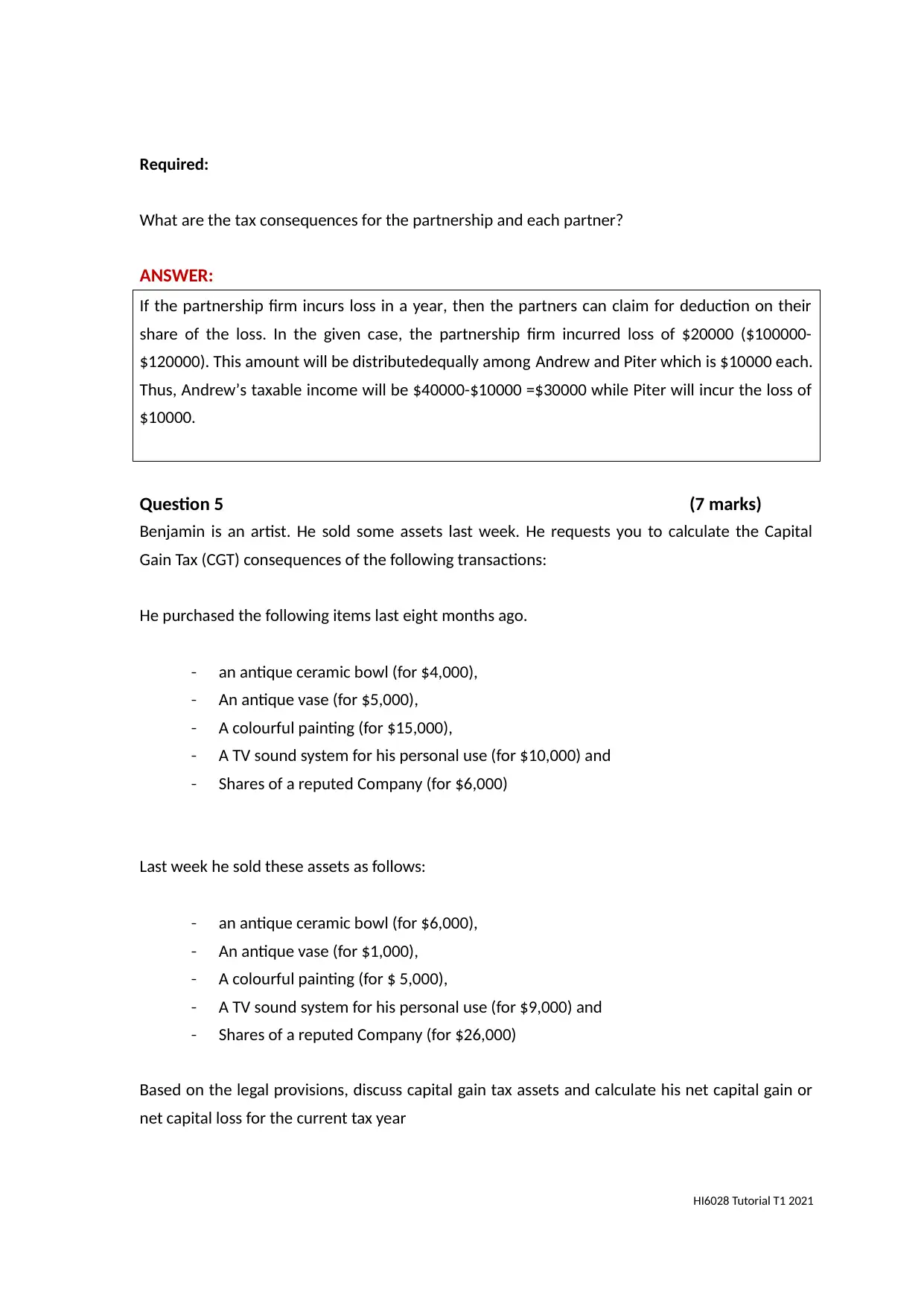
Required:
What are the tax consequences for the partnership and each partner?
ANSWER:
If the partnership firm incurs loss in a year, then the partners can claim for deduction on their
share of the loss. In the given case, the partnership firm incurred loss of $20000 ($100000-
$120000). This amount will be distributedequally among Andrew and Piter which is $10000 each.
Thus, Andrew’s taxable income will be $40000-$10000 =$30000 while Piter will incur the loss of
$10000.
Question 5 (7 marks)
Benjamin is an artist. He sold some assets last week. He requests you to calculate the Capital
Gain Tax (CGT) consequences of the following transactions:
He purchased the following items last eight months ago.
- an antique ceramic bowl (for $4,000),
- An antique vase (for $5,000),
- A colourful painting (for $15,000),
- A TV sound system for his personal use (for $10,000) and
- Shares of a reputed Company (for $6,000)
Last week he sold these assets as follows:
- an antique ceramic bowl (for $6,000),
- An antique vase (for $1,000),
- A colourful painting (for $ 5,000),
- A TV sound system for his personal use (for $9,000) and
- Shares of a reputed Company (for $26,000)
Based on the legal provisions, discuss capital gain tax assets and calculate his net capital gain or
net capital loss for the current tax year
HI6028 Tutorial T1 2021
What are the tax consequences for the partnership and each partner?
ANSWER:
If the partnership firm incurs loss in a year, then the partners can claim for deduction on their
share of the loss. In the given case, the partnership firm incurred loss of $20000 ($100000-
$120000). This amount will be distributedequally among Andrew and Piter which is $10000 each.
Thus, Andrew’s taxable income will be $40000-$10000 =$30000 while Piter will incur the loss of
$10000.
Question 5 (7 marks)
Benjamin is an artist. He sold some assets last week. He requests you to calculate the Capital
Gain Tax (CGT) consequences of the following transactions:
He purchased the following items last eight months ago.
- an antique ceramic bowl (for $4,000),
- An antique vase (for $5,000),
- A colourful painting (for $15,000),
- A TV sound system for his personal use (for $10,000) and
- Shares of a reputed Company (for $6,000)
Last week he sold these assets as follows:
- an antique ceramic bowl (for $6,000),
- An antique vase (for $1,000),
- A colourful painting (for $ 5,000),
- A TV sound system for his personal use (for $9,000) and
- Shares of a reputed Company (for $26,000)
Based on the legal provisions, discuss capital gain tax assets and calculate his net capital gain or
net capital loss for the current tax year
HI6028 Tutorial T1 2021
Paraphrase This Document
Need a fresh take? Get an instant paraphrase of this document with our AI Paraphraser
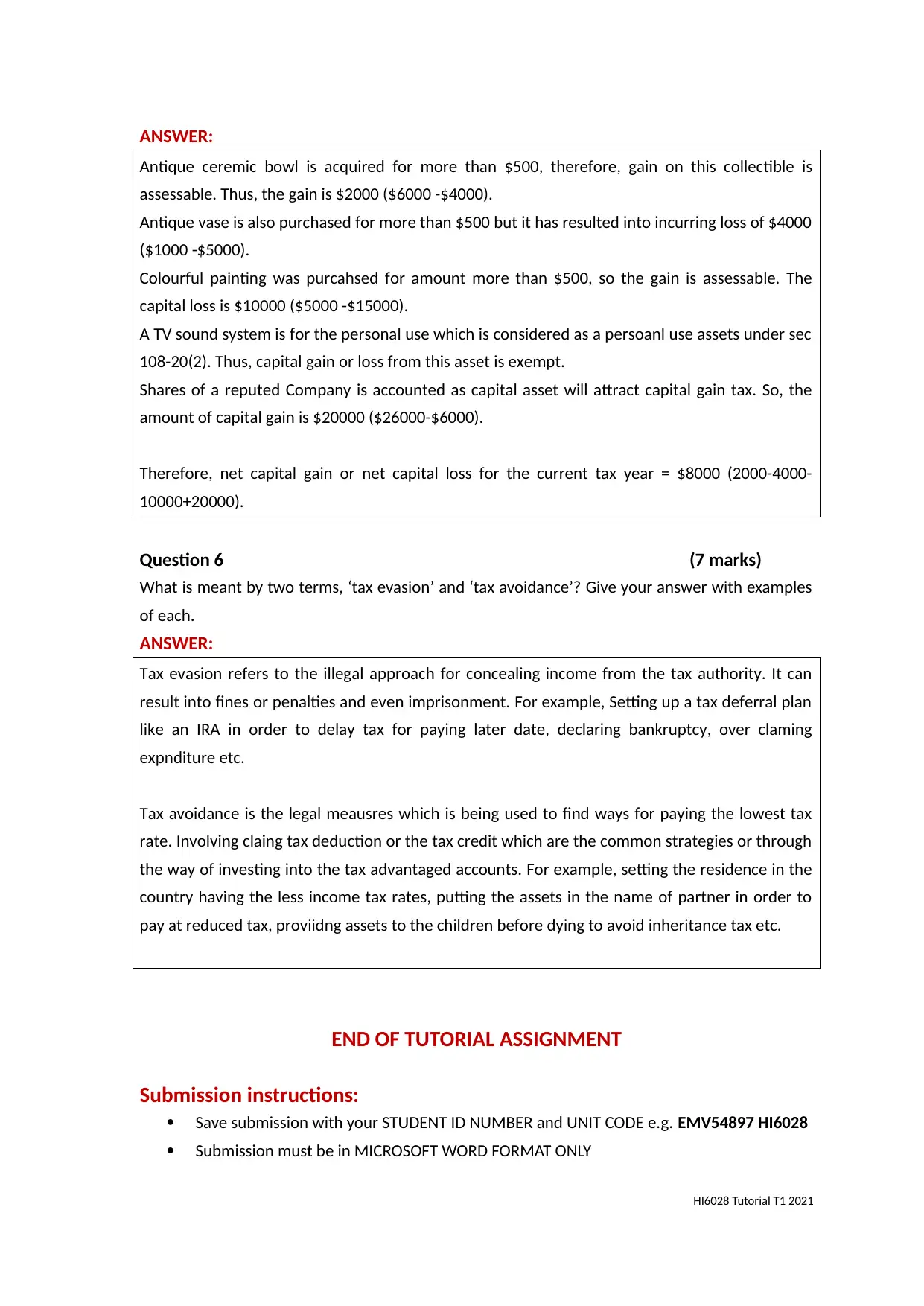
ANSWER:
Antique ceremic bowl is acquired for more than $500, therefore, gain on this collectible is
assessable. Thus, the gain is $2000 ($6000 -$4000).
Antique vase is also purchased for more than $500 but it has resulted into incurring loss of $4000
($1000 -$5000).
Colourful painting was purcahsed for amount more than $500, so the gain is assessable. The
capital loss is $10000 ($5000 -$15000).
A TV sound system is for the personal use which is considered as a persoanl use assets under sec
108-20(2). Thus, capital gain or loss from this asset is exempt.
Shares of a reputed Company is accounted as capital asset will attract capital gain tax. So, the
amount of capital gain is $20000 ($26000-$6000).
Therefore, net capital gain or net capital loss for the current tax year = $8000 (2000-4000-
10000+20000).
Question 6 (7 marks)
What is meant by two terms, ‘tax evasion’ and ‘tax avoidance’? Give your answer with examples
of each.
ANSWER:
Tax evasion refers to the illegal approach for concealing income from the tax authority. It can
result into fines or penalties and even imprisonment. For example, Setting up a tax deferral plan
like an IRA in order to delay tax for paying later date, declaring bankruptcy, over claming
expnditure etc.
Tax avoidance is the legal meausres which is being used to find ways for paying the lowest tax
rate. Involving claing tax deduction or the tax credit which are the common strategies or through
the way of investing into the tax advantaged accounts. For example, setting the residence in the
country having the less income tax rates, putting the assets in the name of partner in order to
pay at reduced tax, proviidng assets to the children before dying to avoid inheritance tax etc.
END OF TUTORIAL ASSIGNMENT
Submission instructions:
Save submission with your STUDENT ID NUMBER and UNIT CODE e.g. EMV54897 HI6028
Submission must be in MICROSOFT WORD FORMAT ONLY
HI6028 Tutorial T1 2021
Antique ceremic bowl is acquired for more than $500, therefore, gain on this collectible is
assessable. Thus, the gain is $2000 ($6000 -$4000).
Antique vase is also purchased for more than $500 but it has resulted into incurring loss of $4000
($1000 -$5000).
Colourful painting was purcahsed for amount more than $500, so the gain is assessable. The
capital loss is $10000 ($5000 -$15000).
A TV sound system is for the personal use which is considered as a persoanl use assets under sec
108-20(2). Thus, capital gain or loss from this asset is exempt.
Shares of a reputed Company is accounted as capital asset will attract capital gain tax. So, the
amount of capital gain is $20000 ($26000-$6000).
Therefore, net capital gain or net capital loss for the current tax year = $8000 (2000-4000-
10000+20000).
Question 6 (7 marks)
What is meant by two terms, ‘tax evasion’ and ‘tax avoidance’? Give your answer with examples
of each.
ANSWER:
Tax evasion refers to the illegal approach for concealing income from the tax authority. It can
result into fines or penalties and even imprisonment. For example, Setting up a tax deferral plan
like an IRA in order to delay tax for paying later date, declaring bankruptcy, over claming
expnditure etc.
Tax avoidance is the legal meausres which is being used to find ways for paying the lowest tax
rate. Involving claing tax deduction or the tax credit which are the common strategies or through
the way of investing into the tax advantaged accounts. For example, setting the residence in the
country having the less income tax rates, putting the assets in the name of partner in order to
pay at reduced tax, proviidng assets to the children before dying to avoid inheritance tax etc.
END OF TUTORIAL ASSIGNMENT
Submission instructions:
Save submission with your STUDENT ID NUMBER and UNIT CODE e.g. EMV54897 HI6028
Submission must be in MICROSOFT WORD FORMAT ONLY
HI6028 Tutorial T1 2021

Upload your submission to the appropriate link on Blackboard
Only one submission is accepted. Please ensure your submission is the correct
document.
All submissions are automatically passed through SafeAssign to assess academic integrity.
HI6028 Tutorial T1 2021
Only one submission is accepted. Please ensure your submission is the correct
document.
All submissions are automatically passed through SafeAssign to assess academic integrity.
HI6028 Tutorial T1 2021
⊘ This is a preview!⊘
Do you want full access?
Subscribe today to unlock all pages.

Trusted by 1+ million students worldwide
1 out of 6
Related Documents
Your All-in-One AI-Powered Toolkit for Academic Success.
+13062052269
info@desklib.com
Available 24*7 on WhatsApp / Email
![[object Object]](/_next/static/media/star-bottom.7253800d.svg)
Unlock your academic potential
Copyright © 2020–2025 A2Z Services. All Rights Reserved. Developed and managed by ZUCOL.




